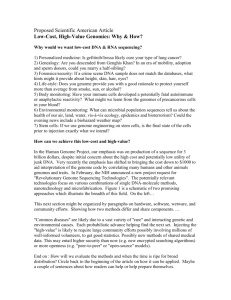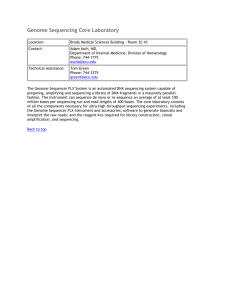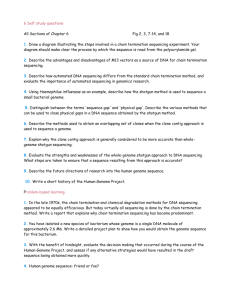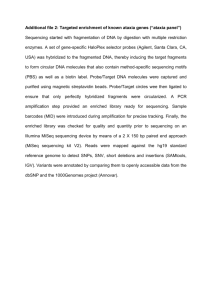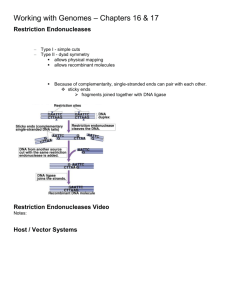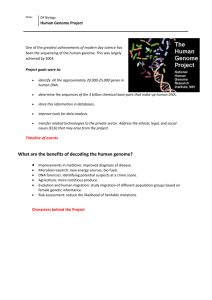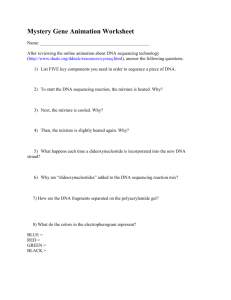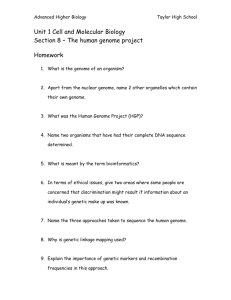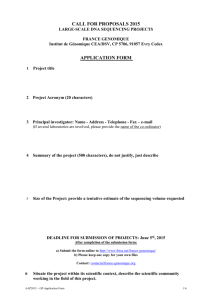An Overview of DNA Sequencing
advertisement
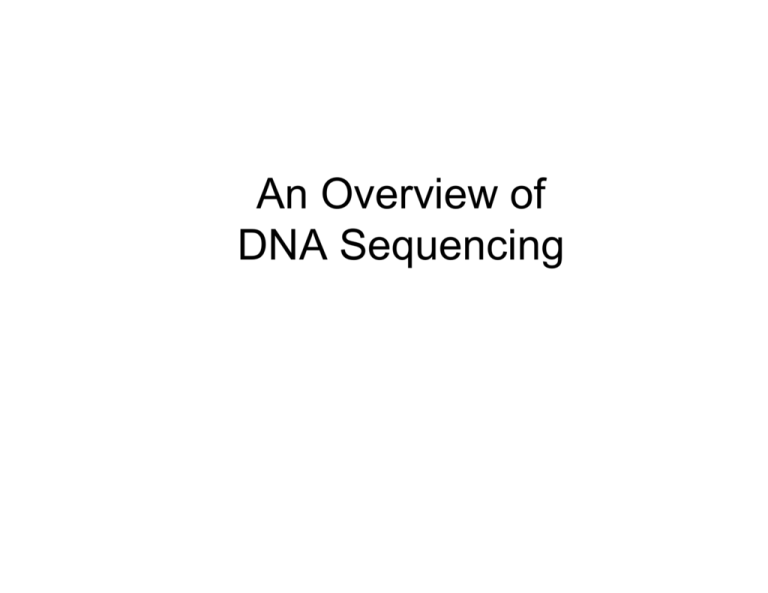
An Overview of DNA Sequencing Prokaryotic DNA Plasmid http://en.wikipedia.org/wiki/Image:Prokaryote_cell_diagram.svg Eukaryotic DNA http://en.wikipedia.org/wiki/Image:Plant_cell_structure_svg.svg DNA Structure The two strands of a DNA molecule are held together by weak bonds (hydrogen bonds) between the nitrogenous bases, which are paired in the interior of the double helix. The two strands of DNA are antiparallel; they run in opposite directions. The carbon atoms of the deoxyribose sugars are numbered for orientation. http://en.wikipedia.org/wiki/Image:DNA_chemical_structure.png Sequencing DNA The goal of sequencing DNA is to tell the order of the bases, or nucleotides, that form the inside of the double-helix molecule. We can do this in one of two ways: • Directed Sequencing • Shotgun Sequencing Directed Sequencing=Primer Walking • Start with genome, gene, clone, PCR product • Design a primer and sequence a certain segment of the genome, usually the beginning. • From that sequence, design the next primer and sequence the next segment of the genome. • Continue designing primers and sequencing until the genome is completed. . Shotgun Sequencing • Start with a whole genome or a large piece of the DNA (a BAC). • Shear the DNA into many different, random segments. • Sequence each of the random segments. • Then, put the pieces back together again in their original order. Theory Behind Shotgun Sequencing 3000 2500 2000 Gaps Haemophilus influenzae 1.83 Mb base Coverage unsequenced (%) 1X 37% 2X 13% 5X 0.67% 6X 0.25 7X 0.09% 1500 1000 500 0 0 20000 40000 60000 80000 Sequences For 1.83 Mb genome, 6X coverage is 10.98 Mb of sequence, or 22,000 sequencing reactions, 11000 clones (1.5-2.0 kb insert), 500 bp average read. BAC based Projects BACs are Bacterial Artificial Chromosomes. They are large transport systems that can hold pieces of DNA that are 50 to 300 kilobases. To make copies of the DNA we insert the BAC into an E. coli cell. transform in E. coli and process each BAC as individual projects chromosome break into large pieces clone into BAC vector Shotgun vs. Directed: Which is the better, more efficient method? • With directed, sequences are done in order and there’s no puzzle to put back together. Minimal computing power is required. • Primers must be continually designed and purchased. • If an area is difficult to sequence, you could get stuck. • Shotgun sequencing takes less time; all the sequences can be done at about the same time. • Minimal cost • But, the pieces have to be assembled, a time-consuming process requiring extensive computational power. Whole Genome Shotgun Sequencing 1.Library construction 2. Random Sequencing Phase a. sequence DNA (15,000 sequences/ Mb) a. isolate DNA 3. Closure Phase a. assemble sequences b. close gaps b. fragment DNA c. edit c. clone DNA GGG ACTGTTC ... d. annotation 237 4. COMPLETE GENOME SEQUENCE 239 238 Library Construction • Construct shotgun libraries of the genome or target DNA; sizes of inserts are varied; could be small (2-3 kb), medium (8-12 kb), or fosmid (30-40 kb) • Start with multiple copies of purified DNA • Shear the DNA using mechanical force, breaking it into smaller pieces • DNA fragments are cloned into a plasmid vector to replicate the DNA; these fragments are called “inserts” Library Construction • • Insert fragment DNA into a vector such as pBR322 Transform into E. coli cells and, using an antibiotic, select for cells that have a plasmid. The plasmids carry antibiotic resistant genes. When plated in the presence of an antibiotic, the cells without a plasmid die. Template Preparation • Isolation of the plasmid DNA • Transformed E.coli is plated onto an agar plate. Every E. coli colony will contain plasmids with the same insert. • Colonies are “picked” & transferred to liquid media where they multiply; use 384 well high throughput plates • Plasmids are isolated and suspended in a buffer. Template Production Laboratory Current Capacity: 22,000,000 plasmids/year Sanger Sequencing • Utilize dideoxy sequencing method of chain termination (Sanger) • Each plasmid is reacted with a forward and reverse primer (2 reactions for each piece of DNA). • Done in high throughput manner in 384 well plates Sequencing reactions -Initial dideoxy sequencing involved use of radioactive dATP and 4 separate reactions (ddATP, ddTTP, ddCTP, ddGTP) & separation on 4 separate lanes on an acrylamide gel with detection through autoradiogram -New techologies use 4 fluorescently labeled bases and separation on capillaries and detection through a CCD camera DNA sequencing R primer binds, synthesis Plasmid Structure Antibiotic resistance F primer binds, synthesis Sequencing Machines • The DNA fragments are loaded into capillaries in the sequencing machines. • Polymer in the capillaries provides a matrix for separating the DNA fragments based on size. • Separation of the fragments through a matrix is called electrophoresis. Sequence Production Laboratory Current Capacity: 40,000,000 sequences/year Data Collection • A laser excites the fluorescent dyes. • A camera detects the fluorescence. • Data collection software collects the data. Capillary array view Sequencing Machine Output AACTCATCGAATCCGTACGGG AACTCATCGAATCCGTACGG AACTCATCGAATCCGTACG AACTCATCGAATCCGTAC AACTCATCGAATCCGTA AACTCATCGAATCCGT AACTCATCGAATCCG AACTCATCGAATCC AACTCATCGAATC AACTCATCGAAT AACTCATCGAA AACTCATCGA AACTCATCG AACTCATC AACTCAT AACTCA AACTC AACT AAC AA A Fluorescent Sequencing Gel Four colors, one lane per sample Fluorescent Sequencing Gel Each fragment differs by one nucleotide This is a diagram of just one lane. Reading from the bottom, where the fragment is only one base long, the fluorescent dye is an A. This is the first base in the sequence. Data Analysis • An chromatogram is produced and the bases are called • Software assign a quality value to each base • Phred & TraceTuner • Read DNA sequencer traces • Call bases • Assign base quality values • Write basecalls and quality values to output files. Assemble Fragments AGCTAGGCTC GCTAGCTAGCT AGCTCGCTA CTAGCTAGCTAGGCTC SEQUENCER OUTPUT AGCTAGC AGCTCGCTAGCTA GCTAGCTAGC TAGCTAGC ASSEMBLE FRAGMENTS AGCTCGCTAGCTAGCTAGCTAGCTAGGCTC GCTAGCTAGC TAGCTAGC AGCTCGCTAGCTA TAGCTAGCTA AGCTAGC AGCTCGCTA CTAGCTAGCTAGGCTC AGCTAGGCTC GCTAGCTAGCT CTCGCTAGCTAG CLOSURE & ANNOTATION TAGCTAGCTA CTCGCTAGCTAG • • FRAGMENTS FROM SEQUENCING PROCESS CONSENSUS SEQUENCE Closure • Assemble the sequence files, relate them to each other, and close gaps • Involves many computational programs to identify overlapping sequences, linkages between sequences • Back to the lab for hard to close gaps Complicating Factors • A procedure that works well in one species may not produce the same results in even a closely related species. • Each genome is uniquely different in its size and how it sequences and assembles • New technologies must be developed to tackle the unique characteristics and properties of difficult genomes Whole Genome Shotgun Sequencing: Modifying for Eukaryotes Not restricted to bacterial organisms Sequence eukaryotes: whole genome draft sequence; same approach as with bacteria chromosome by chromosome; sequence genome using large insert bacterial artificial chromosome (BAC) clones anchored to the chromosomes combination of whole genome and chromosome by chromosome Whole Genome Draft Sequencing 1.Library construction 2. Random Sequencing Phase a. sequence DNA (15,000 sequences/ Mb) a. isolate DNA 3. Closure Phase a. assemble sequences b. close gaps b. fragment DNA c. edit c. clone DNA GGG ACTGTTC ... d. annotation 237 4. COMPLETE GENOME SEQUENCE 239 238 Whole Genome Draft Sequencing 1.Library construction 2. Random Sequencing Phase a. sequence DNA (15,000 sequences/ Mb) a. assemble sequences Advantages: Saves time and money b. close gaps (~50 %) a. isolate DNA b. fragment DNA c. clone DNA 3. Closure Phase GGG ACTGTTC ... Disadvantages: Incomplete c. edit sequence, contains errors d. annotation 237 4. COMPLETE GENOME SEQUENCE 239 238 454 Genome Sequencing System • • • • • • • • • Library prep, amplification and sequencing: 2-4 days Single sample preparation from bacterial to human genomic DNA Single amplification per genome with no cloning or cloning artifacts Picoliter volume molecular biology 100 Mb per run (4-5 hr); less than $ 20,000 per run Read lengths 200-230 bases Massively parallel imaging, fluidics and data analysis Requires high genome coverage for good assembly Error rate of 1-2% 454-Pyrosequencing Construct Single stranded adaptor liagated DNA Perform emulsion PCR Sequencing by Synthesis: Simultaneous sequencing of the entire genome in hundreds of thousands of picoliter-size wells Pyrophosphate signal generation Depositing DNA Beads into the PicoTiter™Plate Expressed Sequence Tags (ESTs): Sampling the Transcriptome and Genic Regions What is an EST? single pass sequence from cDNA specific tissue, stage, environment, etc. cDNA library in E.coli pick individual clones template prep T7 T3 Insert in pBluescript Multiple tissues, states.. with enough sequences, can ask quantitative questions Uses of EST sequencing: -Gene discovery -Digital northerns/insights into transcriptome -Genome analyses, especially annotation of genomic DNA Issues with EST sequencing: -Inherent low quality due to single pass nature -Not 100 % full length cDNA clones -Redundant sequencing of abundant transcripts Address through clustering/ assembly to build consensus sequences = Gene Index, Unigene Set, Transcript Assembly EST Clustering All ESTs and mRNAs from an organism Cluster and Assemble Set of clustered, assembled sequences= contigs, Transcript Assembly, Tentative Consensus, Unigene Longer, more accurate sequence of the transcript Sequences which do not cluster or assemble=Singletons, singlets Single pass transcript Web Links for Animation on Genome Sequencing http://www.jgi.doe.gov/education/how/how30minflash.html http://www.illumina.com/media.ilmn?Title=Sequencing-BySynthesis%20Demo&Cap=&PageName=solexa%20technolo gy&PageURL=203&Media=1 From Fragments to Finished Genome Overview of Sequencing, Assembly, and Closure Processes Genome Sequencing Process Library Construction Clone Picking rDNA Molecules Genome Closure Order Contigs Close Gaps Template Preparation Sequencing Reactions Electrophoresis and Base Calling Genome Assembly Identify Repeats Finish the Genome Annotation Sequence Requirements 1. Free vector should be at low or undetectable level. 2. No chimeric clones. Chimeras occur two or more random fragments from separate parts of the genome recombine and end up next to each other. 3. The majority of the inserts should be of relatively uniform size. 4. Libraries need to be random and cover the whole genome. Basecalling & Quality Assignments Phred & TraceTuner •Read DNA sequencer traces •Call bases •Assign base quality values Warner Brothers, Inc. •Write basecalls and quality values to output files. What are phred quality values? The quality value q assigned to a base call is defined as: q = - 10 x log10(p) where p is the estimated error probability for that base-call. OR A base-call having a probability of 1/1000 of being incorrect is assigned a quality value of 30. Probability Quality Value 1/100 20 1/10 10 Assembling the fragments Merging two sequences overlap (19 bases) overhang (6 bases) …AGCCTAGACCTACAGGATGCGCGGACACGTAGCCAGGAC CAGTACTTGGATGCGCTGACACGTAGCTTATCCGGT… overhang % identity = 18/19 % = 94.7% overlap - region of similarity between regions overhang - un-aligned ends of the sequences The assembler screens merges based on: • length of overlap • % identity in overlap region • maximum overhang size. TIGR Assembler Greedy • Build a rough map of fragment overlaps • Pick the largest scoring overlap • Merge the two fragments • Repeat until no more merges can be done Forward-reverse constraints • • The sequenced ends are facing towards each other The distance between the two fragments is known (within certain experimental error) clone length F R sequenced ends Scaffolding • Given a set of non-overlapping contigs order and orient them along a chromosome I II III IV II III IV I Clone-mates Insert R F I II R Vector F I II R F II I F R Linking information • Overlaps • Mate-pair links • Similarity links reference genome • Physical markers • Gene synteny physical map Grouping the contigs Assembly gaps physical gap group A group B sequencing gaps sequencing gap - we know the order and orientation of the contigs and have at least one clone spanning the gap physical gap - no information known about the adjacent contigs, nor about the DNA spanning the gap Unifying view of assembly Assembly Scaffolding Why Completeness is Important • • • • • • • Improves characterization of genome features • Gene order, replication origins Better comparative genomics • Genome duplications, inversions Determination of presence and absence of particular genes and features is less subjective Missing sequence might be important (e.g., centromere) Allows researchers to focus on biology not sequencing Facilitates large scale correlation studies Controls for contamination What Is Closure? • Obtaining sequence that was not obtained during random sequencing which resulted in: • Sequencing Gaps • Physical Ends • Confirming the integrity of assemblies • Repeats and misassemblies • Verification of Clone Coverage • Confirming the base sequence of the consensus • Editing • Verification of Sequence Coverage Sequence Validation: Sequence coverage 1X 2X 3X Sequence coverage rule: Every base in an assembly must be covered by at least two sequences of high quality. Why? Validating sequence coverage provides a high degree of confidence in the consensus base calls. Sequence editor • In this example there is an obvious discrepancy between the base calls of several of the underlying clones in this region. Causes for gaps • • Non-random shotgun library • Toxicity of genes or promoters in E. coli • Genomic DNA difficult to clone (capsular polysaccharides) • Unstable regions (low complexity) Sequencing problems • Hard stops • Secondary structures • Very high or low GC content • Small unit tandem repeats • Loss of signal • Homopolymeric tracts • Very high or low GC content Closure Challenges: Sequencing Through Secondary Structures Hairpin structure Homopolymeric tracts Solutions • Apply different sequencing chemistries • Big-Dye terminator (default) • Dye-primer • dGTP mix (GC rich regions) • Denature structures - Additives • Betaine • DMSO • Break structure • Restriction digest • Transposon insertion • Micro-libraries Repetitive Areas • • • Repetitive areas are regions of high similarity within the genome/BAC. Sequences in these areas may be misassembled by the Assembler. Verification of the sequence of repetitive areas: • A. Identify potential repetitive areas, using repeatFinder and other tools. • B. Classify repeats based on length, copy number, % similarity, structure and complexity. • C. If repeats are misassembled, transpose spanning clones or obtain PCR products and sequence to verify assembly. Mis-assembled repeat Clones link different repeat flanks Resolved Repeat • Unique flank order is correct • Use linking information across the repeat (large insert clones or PCR) • Consensus sequence is correct • Use linked clones that have one mate in the repeat and the other anchored in unique sequence • Transposon mediated libraries Fasta Format > GDRFE25TF CATTGAACACTAGGAGCCATAGAC………(up to 60 bases per line) GTTCAACCGTTTAAGGCAAAACTTA……… AATTTTGGGCAGACTCTAGATCATG……… GGTAATACATACTCTGGGATTACGA……… Multifasta Format > GDRFE25TF CATTGAACACTAGGAGCCATAGACT………(up to 60 bases per line) GTTCAACCGTTTAAGGCAAAACTTA……… AATTTTGGGCAGACTCTAGATCATG……… GGTAATACATACTCTGGGATTACGA……… > GDRFE45TF ACTGGTTCACATGGAGGGATAGTAC………(up to 60 bases per line) GACACTCCGTAGCTGGCAATCCTTA……… GGCTCTCAATCGAGACTCTAGTTAC……… TCCAATATGGGCTCATGGAACAAGA……… > GDRFE67TF CATTGAACACTAGGAGCCATAGATC………(up to 60 bases per line) AATGTGGCGTAGCTGCCACTTGGTA……… TACCGTCAATCGTATTGTCTAGTTAC……… GGGAGATAATATGGGCTCATATGGT……… >

